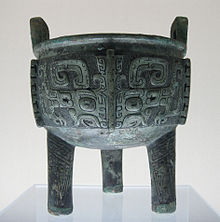Ding (vessel)

A ding (Chinese: 鼎; pinyin: dǐng; Wade–Giles: ting) is an ancient Chinese cauldron with legs, a lid and two handles opposite each other. They were made in two shapes with round vessels having three legs and rectangular ones four.
Dings were originally made of ceramic materials then later, from the time of the Shang Dynasty (1600-1046 BCE), were cast in bronze for "ritual bronzes", which were often buried in the tomb of their owners for use in the afterlife. This is the period to which the oldest examples of dings date back. Inscriptions found on dings and zhongs are used to study bronzeware script. They were used for cooking, storage and the preparation of ritual offerings to ancestors.
In Chinese history and culture, possession of one or more ancient dings is often associated with power and dominion over the land. Therefore, the ding is often used as an implicit symbolism for power. The term "inquiring of the ding" (Chinese: 问鼎; pinyin: wèn dǐng) is often used interchangeably with the quest for power.
Perhaps the most famous ancient dings were the legendary Nine Tripod Cauldrons. This set of bronze vessels is said to have been cast by King Yu of the Xia Dynasty when he divided his territory into the Jiuzhou or Nine Provinces.[1] Later on, possession of all nine was considered a sign of rightful authority over all.[2] The whereabouts of the nine ding are presently unknown, but are said to have been lost during the imperial Qin Dynasty (221-206 BCE), after having been passed among various royal dynasties and feudal states.[3]
The architecture of the Shanghai Museum is intended to resemble a bronze ding.
References
External links
- "Part Two: Bronze Age China: More about Bronze Vessels", National Gallery of Art, Washington, D.C.
- Picture of a ding - The Epoch Times newspaper website (text in Chinese)
- Da Ke Ding, in Shanghai Museum
- Ding (ritual vessels) in Art & Architecture Thesaurus (Taiwan)

